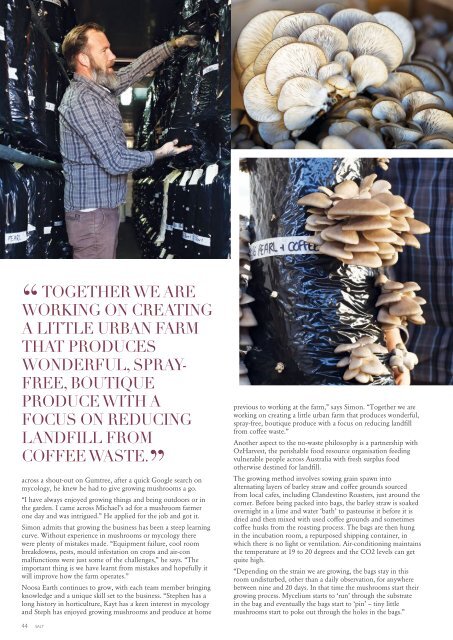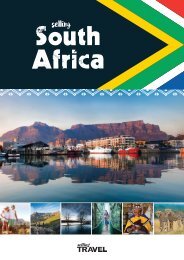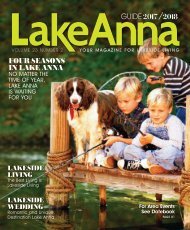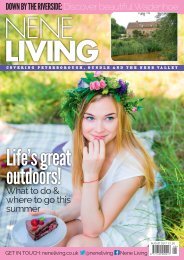salt spring 17
- No tags were found...
Create successful ePaper yourself
Turn your PDF publications into a flip-book with our unique Google optimized e-Paper software.
“<br />
TOGETHER WE ARE<br />
WORKING ON CREATING<br />
A LITTLE URBAN FARM<br />
THAT PRODUCES<br />
WONDERFUL, SPRAY-<br />
FREE, BOUTIQUE<br />
PRODUCE WITH A<br />
FOCUS ON REDUCING<br />
LANDFILL FROM<br />
COFFEE WASTE.<br />
”<br />
across a shout-out on Gumtree, after a quick Google search on<br />
mycology, he knew he had to give growing mushrooms a go.<br />
“I have always enjoyed growing things and being outdoors or in<br />
the garden. I came across Michael’s ad for a mushroom farmer<br />
one day and was intrigued.” He applied for the job and got it.<br />
Simon admits that growing the business has been a steep learning<br />
curve. Without experience in mushrooms or mycology there<br />
were plenty of mistakes made. “Equipment failure, cool room<br />
breakdowns, pests, mould infestation on crops and air-con<br />
malfunctions were just some of the challenges,” he says. “The<br />
important thing is we have learnt from mistakes and hopefully it<br />
will improve how the farm operates.”<br />
Noosa Earth continues to grow, with each team member bringing<br />
knowledge and a unique skill set to the business. “Stephen has a<br />
long history in horticulture, Kayt has a keen interest in mycology<br />
and Steph has enjoyed growing mushrooms and produce at home<br />
previous to working at the farm,” says Simon. “Together we are<br />
working on creating a little urban farm that produces wonderful,<br />
spray-free, boutique produce with a focus on reducing landfill<br />
from coffee waste.”<br />
Another aspect to the no-waste philosophy is a partnership with<br />
OzHarvest, the perishable food resource organisation feeding<br />
vulnerable people across Australia with fresh surplus food<br />
otherwise destined for landfill.<br />
The growing method involves sowing grain spawn into<br />
alternating layers of barley straw and coffee grounds sourced<br />
from local cafes, including Clandestino Roasters, just around the<br />
corner. Before being packed into bags, the barley straw is soaked<br />
overnight in a lime and water ‘bath’ to pasteurise it before it is<br />
dried and then mixed with used coffee grounds and sometimes<br />
coffee husks from the roasting process. The bags are then hung<br />
in the incubation room, a repurposed shipping container, in<br />
which there is no light or ventilation. Air-conditioning maintains<br />
the temperature at 19 to 20 degrees and the CO2 levels can get<br />
quite high.<br />
“Depending on the strain we are growing, the bags stay in this<br />
room undisturbed, other than a daily observation, for anywhere<br />
between nine and 20 days. In that time the mushrooms start their<br />
growing process. Mycelium starts to ‘run’ through the substrate<br />
in the bag and eventually the bags start to ‘pin’ – tiny little<br />
mushrooms start to poke out through the holes in the bags.”<br />
44 <strong>salt</strong>






